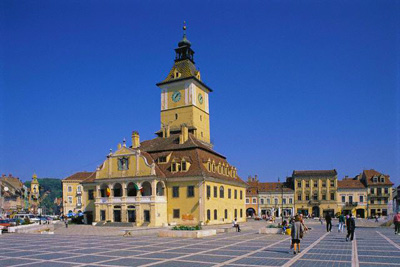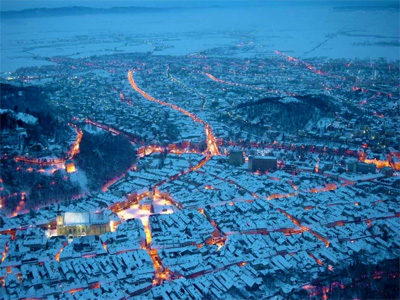The City of Brasov
Brasov, lined with the peaks of the southern Carpathians, splendidly full of Gothic, Baroque and Renaissance architecture as well as an abundance of historical sights, is one of the most visited places in Romania.
Brasov Downtown Brasov was founded in 1211 by the German knights on an old Dacian site and was walled by the Saxons as one of the seven citadels. Brasov exudes a distinctive medieval ambience and has been used as a backdrop in many recent films.
Booking.comMuch before the discovery of written documents, the archaeologists discovered traces of civilisation going back to the Bronze Age. Therefore the site discovered on Dealul Melcilor became well known in Europe. Other archaeological sites found in different places around Brasov prove that there lived a strong community of native population, mixed later on with Roman colonists developing into the Romanian population.
At the beginning 13th century the Saxons (German population coming from the region of Rhein and Mosel) colonised the region of Brasov, finding here a strong Romanian community.
The genuine character of the city will come from the mixture of two different cultures and mentalities.
 The origins of Brasov as a town are lost in the dark times of medieval age. However it is known that it developed as different communities living here decided to come together into a city. The first written documents on Brasov go back to 1235, when the city was mentioned as CORONA, situated on the present location of the Black Church. Later on the city was known also as Brasco, Brasso, Stephanopolis, Kronstadt, and Brasov. However the most popular names of the city are the last two ones. Thanks to geographical position and connections to Moldavia and Valachia, Brasov will grow fast and become one of the most important centres of Transylvania.
The origins of Brasov as a town are lost in the dark times of medieval age. However it is known that it developed as different communities living here decided to come together into a city. The first written documents on Brasov go back to 1235, when the city was mentioned as CORONA, situated on the present location of the Black Church. Later on the city was known also as Brasco, Brasso, Stephanopolis, Kronstadt, and Brasov. However the most popular names of the city are the last two ones. Thanks to geographical position and connections to Moldavia and Valachia, Brasov will grow fast and become one of the most important centres of Transylvania.
The traders of Brasov will have special trade privileges with the other Romanian counties. The free right of bringing goods there will help them develop a very strong craftsmen community. In the 16th century there were more than 45 corporations, grouped according to their field of activity. The craftsmen and traders were the most influential people in Brasov. The economical welfare of the city will make Brasov develop into an architectural jewel. The most important historical monuments were built in that period: The Old City Hall, Podul Batusilor (today hosting the Cerbul Carpatin restaurant), The Old Granary (today the lovely Bistrot de l'Arte), the Black Church (14th century), and the St. Nicolae Church in Scheii Brasovului.
The 14th century found the Turkish armies just South of the Danube River. They were frequently attacking the region of Brasov. This situation determined the citizens of Brasov to start building a strong defensive city wall, fortresses and towers; the work will last till the 18th century. The town will be now one of the strongest cities in Transylvania. The various guilds had each its own towers and fortresses that they would have to maintain and defend throughout the centuries. Today you may see parts of the old city walls or visit the Weavers' Fortress (currently a museum).
 The culture of Brasov will also develop during this period. Johannes Honterus, a great German humanist will work for most of the time in Brasov, and the deacon Coresi will print the first Romanian books here. Therefore in the 16th century Brasov will host several schools, libraries, and printing houses.
The culture of Brasov will also develop during this period. Johannes Honterus, a great German humanist will work for most of the time in Brasov, and the deacon Coresi will print the first Romanian books here. Therefore in the 16th century Brasov will host several schools, libraries, and printing houses.
1688 will be one of the toughest years in the history of Brasov. It will have to fight in the same time with the uprising against the Austrian armies who were occupying Transylvania at the time, with a devastating fire that destroyed most of Brasov, and with outbreak of plague. Still hopeful, the citizens of Brasov will rapidly rebuild the city
The 19th century, the age of progress, as we all know it, will mean a lot for Brasov. The city walls will be partly taken down, allowing a fast development. Manufacturers and factories will replace the old, conservative guilds. Once freed by medieval restraints, the trade will be better than ever for Brasov. This also helped a lot the development of education and media.
"Gazeta de Transilvania", the first Romanian political newspaper in Transylvania, was founded in 1838. This would be the main paper to fight for the independence of Transylvania, which was occupied at the time by the Austro-Hungarian Empire. It was also issuing a literary review that will promote the Romanian writers and poets living in Transylvania.
The first half of the 20th century and especially the period following the 1st world war were times when Brasov became the second strongest economical centre of Romania. However the town was partly destroyed during the bombardments of the 2nd world war.
Fortunately the town recovered every time things went wrong here, mainly because of the outstanding people living here. Thanks to them we are now able to live here and share this privilege with the visitors of the city.
- Romania.org's dedicated website for Brasov
http://www.brasov.ro, http://www.braşov.com, http://www.braşov.net and http://www.brasov.co.ro in Romanian Language - http://www.brasov.edu - Academic and educational portal about Education in Brasov.
- Staying in Brasov for travel, leisure or business
